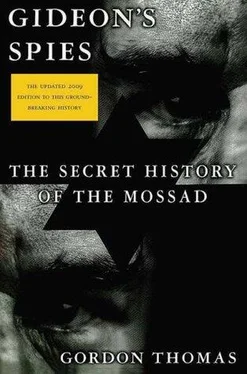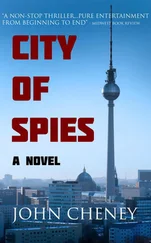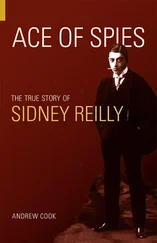Gordon Thomas - Gideon's Spies
Здесь есть возможность читать онлайн «Gordon Thomas - Gideon's Spies» весь текст электронной книги совершенно бесплатно (целиком полную версию без сокращений). В некоторых случаях можно слушать аудио, скачать через торрент в формате fb2 и присутствует краткое содержание. Город: New York, Год выпуска: 2009, ISBN: 2009, Издательство: Thomas Dunne Books, Жанр: История, на английском языке. Описание произведения, (предисловие) а так же отзывы посетителей доступны на портале библиотеки ЛибКат.
- Название:Gideon's Spies
- Автор:
- Издательство:Thomas Dunne Books
- Жанр:
- Год:2009
- Город:New York
- ISBN:978-0-312-53901-6
- Рейтинг книги:4 / 5. Голосов: 1
-
Избранное:Добавить в избранное
- Отзывы:
-
Ваша оценка:
- 80
- 1
- 2
- 3
- 4
- 5
Gideon's Spies: краткое содержание, описание и аннотация
Предлагаем к чтению аннотацию, описание, краткое содержание или предисловие (зависит от того, что написал сам автор книги «Gideon's Spies»). Если вы не нашли необходимую информацию о книге — напишите в комментариях, мы постараемся отыскать её.
Gideon’s Spies
Gideon's Spies — читать онлайн бесплатно полную книгу (весь текст) целиком
Ниже представлен текст книги, разбитый по страницам. Система сохранения места последней прочитанной страницы, позволяет с удобством читать онлайн бесплатно книгу «Gideon's Spies», без необходимости каждый раз заново искать на чём Вы остановились. Поставьте закладку, и сможете в любой момент перейти на страницу, на которой закончили чтение.
Интервал:
Закладка:
He had not—and never would be. Rafi Eitan was satisfied that Shapiro was a genuine patriot, a Zionist who believed in the right of Israel to defend itself. Not only was Shapiro privately wealthy from family money and shrewd stock-market investments, his personal fortune had rapidly increased from the very large profits Numec had already made. Equally, unlike Jonathan Pollard, Shapiro was not a traitor; his love of America was manifest. Rafi Eitan knew that to even attempt to recruit him would be counterproductive. Shapiro would have to remain outside the operation beginning to crystallize in Rafi Eitan’s mind.
Nevertheless, some risks were unavoidable. To learn more about Numec, Rafi Eitan had sent two LAKAM operatives to Apollo. They were Avraham Hermoni, whose diplomatic cover at the Israeli embassy in Washington was “scientific counselor,” and Jeryham Kafkafi, a katsa operating in the United States as a freelance science writer.
Both agents toured the reprocessing plant but were not allowed to photograph it. Shapiro pointed out that would be a breach of Atomic Energy Commission regulations. They had found Shapiro welcoming but, in Hermoni’s judgment, “a man run off his feet.”
Rafi Eitan decided the time had come for him to go to Apollo. He put together a group of “inspectors.” These included two scientists from Dimona with specialized knowledge of reprocessing nuclear waste. Another team member was listed as a director of the “Department of Electronics, University of Tel Aviv, Israel.” There was no such post at the campus; the man was a LAKAM security officer whose task would be to try to discover a way of stealing fissionable waste from the plant. Hermoni was included: his job would be to point out the areas of poor security he had discovered during his previous visit. Rafi Eitan was traveling under his own name as a “scientific adviser to the office of the Prime Minister of Israel.”
The delegates were approved by the U.S. embassy in Tel Aviv and visas were granted. Rafi Eitan had warned the team they could expect to be under FBI surveillance from the time they landed in New York. But, to his surprise, his experienced eyes saw no evidence of that.
The Israelis’ arrival in Apollo coincided with Shapiro’s return from another brainstorming tour of American university campuses, where he had been soliciting scientists who were “friendly” to Israel and would agree to go there and “solve its technical and scientific problems.” He would underwrite all their expenses and make up any deficit in their salaries.
Rafi Eitan and his team’s stay in Apollo was low-key. They took rooms in a motel and spent most of their time at the Numec plant learning the intricacies of converting highly enriched uranium from gaseous uranium hexafluoride. Shapiro explained that Atomic Energy Commission rules meant that Numec would have to pay penalties for any enriched material not accounted for, scaled at $10 a gram, $4,500 a pound.
Rafi Eitan and his spies left Apollo as quietly as they had come.
What followed can only be deduced from FBI reports, and even they leave tantalizing questions as to how much Salman Shapiro may have suspected was behind Rafi Eitan’s visit. An FBI report stated that a month after the Israelis had returned home, Numec became a partner with the Israeli government in a business involving what was described as “the pasteurization of food and the sterilization of medical samples by irradiation.”
Another FBI report complained that “with a warning notice posted on each container that it contained radioactive material, no one would open or examine them—and no one was prepared to let us do so.”
The reason for the refusal was because the Israeli embassy in Washington had made it clear to the State Department that if any attempt was made to inspect the containers, they would place them under diplomatic immunity. The State Department called the Justice Department and warned of the serious diplomatic consequences that would follow any breach of that immunity. All the thwarted FBI agents could do was watch the containers being loaded on to El Al cargo planes at Idlewild Airport.
Despite his best efforts, the CIA station chief in Tel Aviv, John Hadden, said he was unable to “firm up” that the containers were ending up in Dimona. The FBI logged nine shipments in the six months following Rafi Eitan’s visit. They noted that the containers arrived at dusk and left before dawn: all were sheathed with lead, needed to transport enriched uranium, and each container was stamped with a pre-addressed stencil in Hebrew giving Haifa as the final destination. On several occasions, agents saw “stovepipes”—storage containers for enriched uranium—being placed in steel cabinets at the Numec loading dock. Each stovepipe bore a number showing it had come from the company’s high-security vaults. But there was still nothing the FBI could do. An FBI memo spoke of “political pressure from State [Department] not to create a diplomatic incident.”
After ten months the shipments abruptly stopped. The FBI could only assume that sufficient quantities of fissionable material had by then reached Dimona. During the agency’s subsequent interviews, Shapiro denied he had supplied Israel with nuclear bomb-making material. The FBI said their check of company records showed there was a discrepancy in the amount of material reprocessed. Shapiro insisted the “most logical explanation” for any “lost” uranium was that it had seeped into the ground or had been “disposed of into the air.” All told, the missing material amounted to one hundred pounds. Shapiro was never charged with any crime.
In the years that followed, Rafi Eitan could be forgiven for thinking how easy it had become to steal fissionable materials after the collapse of the Soviet Union. An incident that took place at Sheremeteyevo Airport in Moscow on August 10, 1994, proved exactly that.
At 12:45 P.M. on that day, Justiano Torres, somberly dressed in a gray business suit bought for this one journey, arrived deliberately late for Lufthansa Flight 3369 to Munich. Physically strong, he still sweated a little under the weight of the new black-leather Delsey suitcase. Torres produced his first-class ticket and smiled at the desk clerk. The smile was captured on a camera secretly installed behind the desk to record his every movement.
Other cameras had secretly filmed him over these past months. Captured on film were his meetings with a disaffected Russian nuclear scientist, Igor Tashanka: their encounters out in the Stalin Hills; their trips on a pleasure steamer on the Moscow River; their dinners at Russian mafia-controlled restaurants; and finally, the meeting where Tashanka passed over the suitcase and in return received an envelope containing $5,000. In every sense, Torres could believe he had struck a wonderful bargain. The suitcase contained fissionable material.
Justiano Torres was a courier for a Colombian drug cartel who had expanded into trafficking in an even deadlier substance. The suitcase contained, in sealed containers, the two hundred grams of plutonium 239 that Tashanka had sold him. It had a street value of $50 million. The plutonium was so lethal that even coming in contact with a microscopic speck would be fatal. The contents of the suitcase were sufficient to make a small nuclear device.
For Uri Saguy, the former head of Israeli military intelligence, the prospect was “every thinking person’s nightmare: a bunch of terrorists with their hands on enough fissionable material to devastate Tel Aviv or any other city. In day-to-day intelligence tasking, dealing with a nuclear threat ranks right at the very top.”
The Israeli intelligence community had long known that terrorists could manufacture a crude nuclear bomb. An American physics graduate student in the 1970s had carried out and described each one of the processes required. His published work caused huge consternation with Mossad.
Читать дальшеИнтервал:
Закладка:
Похожие книги на «Gideon's Spies»
Представляем Вашему вниманию похожие книги на «Gideon's Spies» списком для выбора. Мы отобрали схожую по названию и смыслу литературу в надежде предоставить читателям больше вариантов отыскать новые, интересные, ещё непрочитанные произведения.
Обсуждение, отзывы о книге «Gideon's Spies» и просто собственные мнения читателей. Оставьте ваши комментарии, напишите, что Вы думаете о произведении, его смысле или главных героях. Укажите что конкретно понравилось, а что нет, и почему Вы так считаете.












